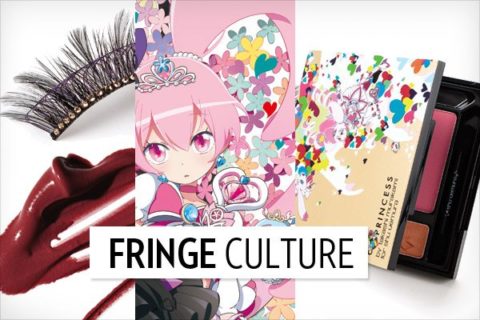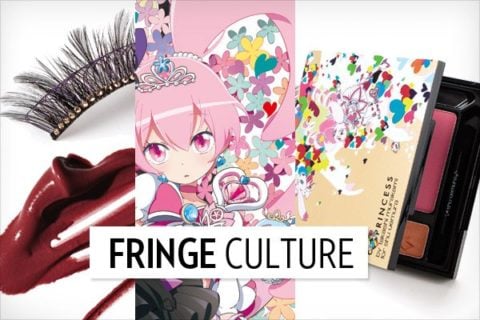Shu Uemura x Takashi Murakami: Tokyo’s otaku subculture meets makeup in an artful collaboration


It’s a sunny day in Tokyo and a group of anime princesses and warriors are becoming uncomfortably warm in their latex and polyester costumes. They’re “cosplay” enthusiasts leading a group of tourists through Akihabara, the area known for attracting those into otaku culture, characterized by an obsessive interest in anime, manga or video games. During a pit stop at a “maid cafe,” hostesses in frilly French maid outfits (a popular strain of anime character) pour blue and green sodas and perform J-pop numbers. Do they dress differently after work? “Oh, this isn’t work,” says one, wearing eyelid tape and huge fake lashes. “It’s our lifestyle.”
Otaku culture is the focus of Japanese brand Shu Uemura’s holiday collection (from $27, shuuemura.ca), created with Takashi Murakami. The artist famous for stamping his colourful designs on Louis Vuitton Speedy bags in 2002 emblazoned the makeup’s packaging with Six Heart Princess, his anime artwork based on the legend of a warrior princess. “It’s a very dark story about people who were born into a cursed family and are not able to break away from their blood,” he says. Cheerful! “I tried to create something that would not be dubbed as modern art but that was totally Japanimation style.”
“It’s Japanese subculture translated into art, so it’s a very edgy and interesting approach,” says Kakuyasu Uchiide, Shu Uemura’s international artistic director. “It was a bit of a challenge for us to express his kind of beauty.”
Eyeshadow palettes are split into the duelling sides of Six Heart Princess’s personality: soft pinks and dramatic blacks. There are tubes of creamy cheek-and-lip tint, a first for the brand, and two false lashes: a feathery pair tipped with fuchsia hearts and a strip of black feathers that resembles an arrow’s fletching.
The collection also includes a new version of the brand’s famous eyelash curler, which was originally designed in 1991. “The trend for using exaggerated lashes to make the eyes appear bigger probably originated in Japan and then reached Western culture,” says Uchiide. The curved clamping surface has been truncated so that it grasps only a centimetre at a time, ensuring no lash remains uncurled. This winter, it bears a Murakami-designed charm, like the cellphone jewellery beloved by Tokyo girls.
“Mr. Murakami translates a playful mindset into art, so from that viewpoint his work and our work are very similar,” says Uchiide. Indeed, the coloured bears that wear the fake lashes on the counter displays could have been plucked from a Murakami sculpture. While the artist admits he hasn’t thought much about makeup before now, his fascination with otaku culture provided an entry point. “If you think about the people who do cosplay, they try to make themselves into animation characters that have natural hair and a natural face,” he says. “They utilize makeup to become a totally different person. But this makeup thing is something that women do every day, to transform themselves.”
Murakami is the latest in a line of collaborators—Karl Lagerfeld, Wong Kar Wai, Viktor & Rolf—who are as creative as the late Shu Uemura himself. “I think that Mr. Shu was very much unlike a Japanese person,” says Murakami, who was introduced to Uemura shortly before his death in 2007, by the president of Louis Vuitton. “I think he only looked at the future. He didn’t care just about business.”
Uemura enrolled in beauty school in the 1950s because he was attracted to what he called “a field that hadn’t yet been cultivated,” and went on to work as a makeup artist on Hollywood film sets—he turned Shirley MacLaine into a geisha for her role in the 1962 comedy My Geisha. He started his business in Tokyo in 1967 by selling an early version of the now-renowned cleansing oil, based on a product used by actors to wash off stage makeup.
Like Murakami, who has lived in the U.S. and seen his works sell for millions of dollars worldwide, Uemura built a Japanese brand (over 80 per cent of the stores are in Asia) whose wares are sought by aficionados in 18 countries.
If, to an outsider, otaku seems a little lost in translation, it comes as no surprise to Murakami. “Karl Lagerfeld has talked about manga and put it into fashion, but otaku is like the pickled plum on the side,” he says. It’s not essential to fully understand its nuances to appreciate the vibrant artwork and wearable makeup, but it does provide food for thought as you’re applying your Heroine Rose lip and cheek tint. “This time, as a brand from Tokyo, I wanted to express Tokyo edginess,” says Uchiide. Mission accomplished.







